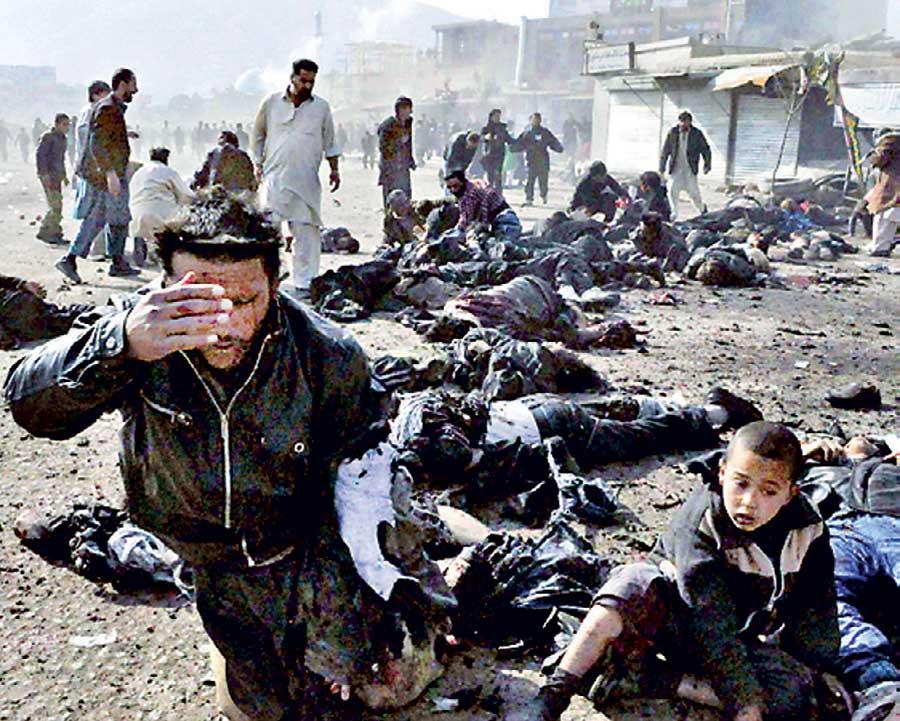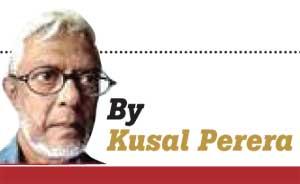Reply To:
Name - Reply Comment
Last Updated : 2024-04-20 00:00:00

After the end of WW II, in October 1945, 50 countries (Poland signed later making it 51) including the US, Britain, France, China (it was actually Taiwan) and Soviet Russia formed the United Nations and declared, “WE THE PEOPLES OF THE UNITED NATIONS are DETERMINED to save succeeding generations from the scourge of war, which twice in our lifetime has brought untold sorrow to mankind and to reaffirm faith in fundamental human rights, in the dignity and worth of the human person, in the equal rights of men and women and of nations large and small and to establish conditions under which justice and respect for the obligations arising from treaties and other sources of international law can be maintained and to promote social progress and better standards of life in larger freedoms”, making it the vision, mission and sole responsibility of this new world body. The United Nations now have 193 member countries which have also accepted the same Charter.
Accepting such a noble responsibility by almost all the countries the world over should have left peace and human dignity in abundance on Planet Earth. New generations after the Second WW should have grown wholly unaware of wars except in text books. Standing armies, manufacture of military hardware should have become obsolete by now, left as museum exhibits and literature for new generations. Nuclear power should have been turned into societal use of consumers and not as “threatening” and risky “power” in the hands of aggressive States.
But what happened to the UN’s determination and responsibility “to save succeeding generations from the scourge of war” was just the opposite. Major players of global power in the UN Security Council (UNSC) kept investing in improving and modernising the technology for manufacture of military hardware and for military surveillance and intelligence gathering. It was the silent and undeclared race between the US and Soviet Russia to be the world economic “super” power that has triggered the new arms race. 
The brutal use of the A-bomb on Nagasaki and Hiroshima by the US was not mere revenge over Japan’s Pearl Harbour bombing. It was perhaps to tell all “Allies” in general and Soviet Russia in particular that post-WW II politics would have to be decided on US terms. That instead provoked Soviet leaders to accelerate their Nuclear power project and surprised US leaders when Soviet Russia tested its first A-bomb in 1948. That led to heavy and improved manufacture of military hardware, despite the UN Charter for peace and human dignity. “Throughout the second half of the twentieth century, the introduction of new technologies led to remarkable advances in the manufacture of aircraft, missiles, ships, satellites, land vehicles, electronic equipment, and many other weapons and supporting systems employed by the Army, Navy, Air Force and the Marine Corps” is the opening sentence in the Forward to “Re-arming for the Cold War – 1945 to 1960”, a study by the “Historical Office” of the “Office of the Secretary of Defence, Washington DC” in 2012”.
In its Preface it says, “…from the end of World War II through the mid 1990’s the United States spent over $5 trillion (including the cost of the wartime atomic bomb project) on the development, production, and deployment of nuclear weapons, and on the systems for delivering and defending against them. Twenty percent of that sum was expended between 1945 and 1960”
After the Second WW, during the decade of the 50s, UNSC members raced to gain increasing shares in the world’s weapons market, completely ignoring their own pledge to the world for peace, stability and dignity. The US gained 35.2 per cent, the Soviet Union 34.2 per cent, Britain 21.4 per cent, France 02.3 per cent and Taiwan listed as China was left a mere nonentity. (SIPRI Arms Data base). Yet, “religious extremism” was never a subject for discussion till the prolonged armed conflict in Afghanistan, engineered by the US in 1979. The two major wars till then, the Korean and the Vietnam war were never about religious fanaticism. Nor was the Suez Canal conflict between Egypt and Israel directly backed by Britain and France.
What then brought “Islamic fundamentalism” to the forefront as a major factor in armed conflicts and civil war? Saudi Crown Prince Mohammed bin Salman had an “off the record” interview with “Washington Post” in mid March 2018. It was later published on 22 March as a carefully edited article with approval from Saudi Embassy authorities titled, “Saudi Prince denies Kushner is ‘in his’ Pocket”. In that heavily edited article, answering a question on “Saudi funded spread of Wahhabism accused of being a “source of global terrorism”, Prince Mohammed said, “Investments in mosques and madrassas overseas were rooted in the ‘Cold War’, when allies asked Saudi Arabia to use its resources to prevent inroads in Muslim countries by the Soviet Union”. Allies, Prince Mohammed refers to, no doubt was Washington. Madrassas in Pakistan were schools that taught Wahhabism in its extreme form to turn out “Taliban” fighters in Afghanistan as answer to “prevent inroads in Muslim countries by the Soviet Union”.
Around the year 2000, two French “Intelligence Analysts” Jean-Charles Brisard and Guillaume Dasquie published a book titled “Bin Laden, La Verité Interdite”. In that they quote Deputy Director (Investigations) of FBI, John O’Neil who resigned from his post over differences of opinion on Afghanistan with President Bush, as having told them, “The main obstacles in investigating Islamic terrorism (Taliban) were US oil corporate interests and the role played by Saudi Arabia.” Rich oil fields in Central Asia are said to hold as much as one third of the total reserves in the Persian Gulf.
"That instead provoked Soviet leaders to accelerate their Nuclear power project and surprised US leaders when Soviet Russia tested its first A-bomb in 1948"
With all indications the global neo-liberal economy was running into stagnation and to a possible meltdown in a few years to come, the US was determined to encroach upon other oil reserves in the Middle East and North Africa in their bid to have control over the global economy. Vali Nasr, an associate professor at the University of San Diego, specialising on Saudi Arabia and Islamic fundamentalism says, “In fact, this whole phenomenon that we are confronting, which Al Qaeda is a part of, is very closely associated with Saudi Arabia’s financial and religious projects for the Muslim world as a whole.” He then gave his explanation for Saudi Regime’s proxy work for the US. “There’s no country in the Middle East with which we (US) are as intertwined as Saudi Arabia. American oil companies ensured the rise of the Saud family, ensured the dominance of the Saud family over Saudi Arabia. The very fact that the peninsula was integrated together into one single kingdom, one single nation State, has a lot to do with US presence in the country.” Nasr told “Frontline”. (https://www.pbs.org/wgbh/pages/frontline/shows/saudi/interviews/nasr.html)
While Taliban still remains a serious threat to Afghanistan’s stability, the Al Qaeda was crushed and Bin Laden assassinated to give that space to the ISIS for a different project. The ISIS it is claimed by another geo political analyst Tony Catalucci based in Bangkok, is a product of the US, created through NATO. In his article, “NATO’s Terror Hordes In Iraq A Pretext For Syria Invasion” he argues, “In actuality, ISIS is the product of a joint NATO-GCC [Gulf Cooperation Council] conspiracy stretching back as far as 2007 where US-Saudi policymakers sought to ignite a region-wide sectarian war to purge the Middle East of Iran’s arch of influence stretching from its borders, across Syria and Iraq, and as far west as Lebanon and the coast of the Mediterranean.” ISIS turned out in the most brutal anti-Christian form of Islamic fundamentalism and attracted “activists” from across Europe and North America with heavy publicity in Western media than all other terrorist groups including Al Qaeda put together. The US-Saudi project that eliminated Saddam Hussein in Iraq and Muamar Gaddafi in Libya, nevertheless turned out a cropper with ISIS failing to dislodge President Bashar al-Assad and his regime in Syria.
"The very fact that the peninsula was integrated into one single kingdom, one single nation State, has a lot to do with US presence in the country"
During the five years up to 2017, value of weapon sales increased by 10 per cent compared to the previous five years with the Syrian and Yemeni wars in particular and the Middle East caught in conflicts all round. US arms sales thus increased from US$9,601 million in 2014 to US$52,480 million in 2018. During that same period, France increased from US$1,643 million to US$9,948 million, Germany from US$1,790 million to US$9,324 million, while Britain increased from US$1,651 to US$6,171 million. China in the UN Security Council is now the PRC since 1971 and not Taiwan anymore. Their share increased from US$1,160 million to US$7,633 million. (SIPRI data). All these decades, permanent members of the UNSC kept gaining more dollars with every armed conflict that left human tragedies in countries and regions outside of theirs.
With Taliban restricted to Afghanistan, Al Qaeda wiped out and the ISIS crushed by Russian-backed Kurdish and Syrian forces, all permanent members in the UNSC would have to find big time armed conflicts elsewhere to earn the dollars they earned from civil wars during the past years. There will therefore have to be a new form of “terrorism” in a new region or the ISIS will have to be revived on a larger map for UNSC members to make profits while pushing their geopolitical agenda. With US spoken of in a battle for supremacy in the Indian ocean, the question is what or who next will remain high in South Asian politics in the months to come.

Add comment
Comments will be edited (grammar, spelling and slang) and authorized at the discretion of Daily Mirror online. The website also has the right not to publish selected comments.
Reply To:
Name - Reply Comment
On March 26, a couple arriving from Thailand was arrested with 88 live animal
According to villagers from Naula-Moragolla out of 105 families 80 can afford
Is the situation in Sri Lanka so grim that locals harbour hope that they coul
A recent post on social media revealed that three purple-faced langurs near t